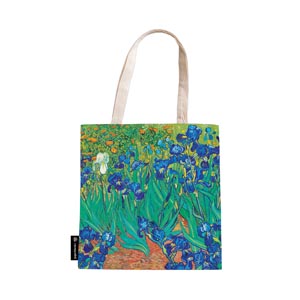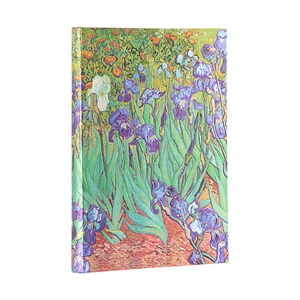
Introducing an exclusive collaboration with the Getty, with its world-class museum – home to one-of-a-kind works of art including paintings by European masters, historic illuminated manuscripts and gorgeous outdoor sculpture gardens.
This collection is a front-row pass to the Getty’s sought-after treasures. Our collaboration began in Spring 2022 with our first release, Vincent van Gogh’s iconic Irises.
Our Partnership with the Getty
A Shared Passion
The Getty is a leading international art organization that is dedicated to inspiring human connections and understanding through art.
“Our partnership with the Getty was born with a common purpose of educating people about exquisite works of art and craftsmanship, and united by high quality standards.” – Adina Costiuc, Paperblanks Graphics Development Manager
Partnering with such a venerable institution is an inspiring opportunity to bring together our mutual passions for creating meaningful connections through personal expression and shared cultural experiences.


A Growing Relationship
Paperblanks and the Getty have long enjoyed a fruitful relationship, with the museum’s store carrying Paperblanks products for many years.
In 2018, we began to brainstorm ways to take this connection further, and it seemed a natural fit to create a special collection featuring pieces from the Getty Museum as our next step. After all, how better for a museum visitor to commemorate their visit than by taking home a special journal or canvas bag featuring the works of art they just saw?

Creating This Exclusive Collection

Working Together
After the first discussions in 2018, we began to work together – browsing the museum’s collection, working on the details of the collaboration and testing product samples.
The fact that the Getty Museum houses a collection that is so diverse and historically significant made it difficult to choose where to begin, but we knew we wanted to work with an instantly recognizable image to share their collection with the world.
Photo credit: Scholars looking at archival material from the Getty Research Institute’s Special Collections. Courtesy J. Paul Getty Trust

Developing the First Release
Dutch artist Vincent van Gogh (1853–1890) was one of the greatest of the Post-Impressionist painters, and his painting Irises is one of the Getty Museum’s most prized holdings. The near spiritual excitement of his swirling brushwork, contoured forms and intense colour has had a powerful influence on the development of modern painting.
“Van Gogh’s renowned artwork provided Paperblanks with the perfect canvas for showcasing our special printing techniques. The painting itself exudes movement and evokes a sense of unity with nature. Our addition of gold foil and delicate highlights enhances the vibrancy and dynamism of the piece – like glimmering sunlight dancing on petals. Working on this project has brought us immense pleasure, and we hope that we’ve successfully conveyed this sensitivity to our cherished customers. We were drawn to the camaraderie and celebratory atmosphere radiating from this artwork. So, we harnessed our printing techniques to enhance its beauty even further” – Adina Costiuc, Associate Art Director


Our Ongoing Partnership
With our mutual passion for creating meaningful connections through personal expression and shared cultural experiences, we’re delighted to introduce Lawrence Alma-Tadema as our latest co-branded series release with the Getty this Fall 2024. Through this ongoing partnership we hope to continue to channel our shared philosophies and present a wonderful tool of personal expression for all.

Introducing the J. Paul Getty Museum Collection

Van Gogh’s Irises
A severe mental health crisis, in which he now-famously cut off his own ear, prompted Van Gogh to admit himself to the Saint-Paul Asylum at Saint-Rémy in the south of France. His recuperation began with painting of the asylum garden, Irises chief among the resulting output. The close study of nature was the foundation of Van Gogh’s art, as his precise delineation of individual flowers suggests, but he also brought to that study an astonishing degree of subjective intensity. One can emotionally feel the painting’s strong colours, thickly applied paint and powerful decorative rhythms, all of which convey the artist’s sense of nature’s surging vitality.
“Visitors from all across the world visit the Getty Museum to see our famous Van Gogh painting. It’s no surprise that it’s a favorite, and often the first destination upon arrival at the Getty Center. With this collaboration, ‘Irises’ will reach many new audiences and perhaps inspire a deeper study of the artist’s work and visits to our Los Angeles campus.” – Thomas Stewart, Getty Head of Merchandise Development and Retail Store Operations
We are honoured to feature this seminal painting from the Getty Museum in our new collaborative collection. Be sure to check out this beautiful and historic institution the next time you visit California, and stay tuned for what comes next in our ongoing collaboration with the Getty.

Ancient Illumination
Displaying astounding naturalistic illusionism, the Spinola Hours is one of the most visually sophisticated 16th-century Flemish manuscripts. A true reflection of what makes Paperblanks unique, our new Ancient Illumination series embodies harmonious design with delicate detailing that translate to enhanced beauty on the cover of our Paperblanks journals. We are delighted to partner with Getty to reproduce this richly illuminated manuscript page and its beautiful calligraphy.
The original work contains texts including a calendar of Church holidays, the Hours of the Virgin (a cycle of prayer services devoted to the Virgin Mary), the Office for the Dead, and other prayers, hymns and readings. This particular example augments these contents with a special series of weekday offices and masses, providing even more possibilities for rich illuminations. In the 1700s it belonged to the Spinola family in Genoa, from whom it takes its modern name.
We are honoured to feature this unparalleled example of illumination from the J. Paul Getty Museum as the latest addition to our collaborative collection.
.webp?0307202346)

Lawrence Alma-Tadema - Spring
In his
“Alma Tadema’s artistic gift lies in his ability to infuse each person in this painting with expressive faces. The street party depicted here becomes a celebration of life – a gathering where people of all ages, genders, and skin colours come together in the spirit of friendship and equality. Against the backdrop of natural fabrics and marble, the vibrant, eye-catching flowers bloom.” – Adina Costiuc, Associate Art Director



















